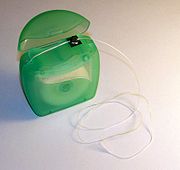
Dental floss (floss) is a special thread for cleaning interdental spaces from plaque [1] . Using a toothbrush allows you to clean only three of the five surfaces of a person’s tooth . The remaining two surfaces between the teeth need special care, since plaque and pieces of food from the interdental spaces cannot be removed with a brush. Therefore, caries often begins here. The use of threads for the treatment or prevention of gingivitis is impractical [2] . Today, dental floss is the main tool for cleaning the interdental spaces (approximate surfaces) of the teeth. It is advisable to use it after each meal. Or at least during evening brushing.
Content
- 1 Contraindications to the use of floss
- 2 Materials and types
- 3 Application Method
- 4 See also
- 5 notes
- 6 Literature
- 7 References
Contraindications to the use of floss
Before use, make sure that there are no contraindications. These include:
- Periodontal disease and bleeding gums. Frequent use of floss leads to the appearance of wounds on the gums, the development of inflammation in the oral cavity.
- Caries. The danger of flossing is explained by the likelihood of pieces breaking off from the teeth.
- Crowns or bridges. Orthodontic microprostheses involve the use of a superfloss dental accessory that combines the functions of various types of this product.
Materials and Views
Dental floss is made from natural silk or artificial fibers ( acetate , nylon , nylon ).
Dental floss can be of the following types:
- waxed - impregnated with wax , due to which it penetrates into narrow spaces more easily
- Unwaxed - cleans better
The cross section of dental floss is:
- round - for wide spaces
- flat - for narrow spaces
- volumetric - increases in diameter (swells) in contact with moisture (saliva)
- ribbon form - for wide gaps ( diastem and three )
Dental flosses also vary in floss composition.
- Soaked . These are threads that are impregnated with special compounds. It can be simple flavors designed to freshen your breath, antiseptics that ensure the destruction of bacteria, or fluorine-containing ingredients that provide strengthening of tooth tissues and prevent the development of caries. A thread with menthol leaves a pleasant taste and a feeling of freshness in the mouth. A fluoride thread strengthens the enamel and prevents tooth decay. Impregnation with red pepper extract (capsaicin) is designed to improve blood circulation in the gums. It is possible to cut the gum with a thread, leaving a hard-to-heal wound, so with pepper soaking you need to be especially careful.
- Not soaked . Additional chemical compounds in the composition of the fiber are not used.
Most often, dental floss is produced in small rolls with a built-in cutter in the form of a protruding tongue (like a needle on an all-metal button, but at an acute angle and with a rounded end).
Application Technique
A thread 20-30 cm long is wound on the middle fingers and pulled with the thumb and the left index finger. In a tense state, the thread is inserted into the interdental space, gently lowered until it comes into contact with the gum (without damaging the gum), pressed to the contact surface of the tooth, and in this position make 6-7 movements in the anteroposterior direction to the cutting edge. The thread is advanced moderately so as not to injure the gums. Thus, all teeth pass. In case of gum disease, the doctor may recommend cleaning the interdental spaces with a special brush.
See also
- Personal oral hygiene
- Tooth brushing technique
Notes
- ↑ Smoking, Gum Disease, and Tooth Loss . Tips From Former Smokers . CDC Date of treatment December 3, 2017.
- ↑ Berchier CE, Slot DE, Haps S, Van der Weijden GA The efficacy of dental floss in addition to a toothbrush on plaque and parameters of gingival inflammation: a systematic review , 2009 (English)
Literature
- Flossing for the management of periodontal diseases and dental caries in adults / Cochrane Oral Health Group, 2011 DOI: 10.1002 / 14651858.CD008829.pub2
Links
- Rafi Letzter . Should you floss before or after you brush? (English) , businessinsider (Aug. 3, 2016). Date of treatment December 3, 2017.
- https://www.nytimes.com/2016/08/03/health/flossing-teeth-cavities.html
- Floss / Interdental Cleaners / American Dental Institute, 2017
- http://www.medicaldaily.com/dental-hygiene-tooth-decay-flossing-dont-forget-floss-389195
- https://zub.dental/gigiena/zubnaya-nit / Selection rules and dental floss application technique (Russian)